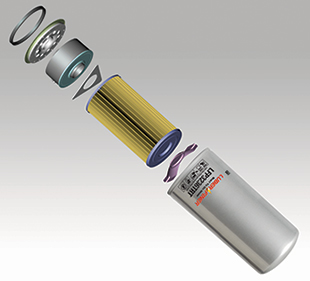Today’s heavy-duty oil filtration has been impacted by several new trends that can improve a vehicle’s efficiency, extend drain intervals and positively affect a company’s bottom line.
Filter media that use synthetic fibers are not new, but recent technology has developed that dispenses highly effective liquid additives into synthetic media filters, a combination that provides impressive results. This technology—combined with the important insights gained from regular oil analysis—offers contractors and fleet managers oil filter options that can help improve the efficiency of their fleets.
No longer can one kind of filter meet the needs of every heavy-duty truck or machine. Instead, today’s best oil filters can be matched to a vehicle’s oil analysis profile. Once oil analysis has been completed on a vehicle, owners can select the ideal filter to provide optimum additional protection, supply additional additives to extend change intervals and increase filtration levels for severe service environments. Filter options are available for both soot-challenged engines and acid-challenged engines.
A universal truth in filter fiber science is that finer fibers are required to attain finer filtration. With 100 percent synthetic (micro-glass, polyester, etc.) media, durable filtration with high-filtering efficiency that does not increase flow restriction is now commonplace. This filtration can offer extended drain intervals and more efficient vehicle operation.

Oil additives are critical for extending the useful life of oil and adding to its protective abilities. Oil formulations have evolved over the years and are about to change yet again with the pending introduction of PC-11 formulations in 2015. In addition, recent innovations in oil filter technology are improving efficiency simply by delivering additives to engine oil.
The emergence of new federal emissions regulations has impacted the technology of new heavy-duty diesel engines. In some cases, the implementation of the exhaust gas recirculation (EGR) system has had a negative effect
on oil life, and the necessary timing adjustments to optimize emissions have resulted in higher engine and oil temperatures. These critical factors accelerate the oxidation process and overall degradation within the oil, resulting in increased soot levels, shortening of drain intervals and accelerating acidity.
Based on the challenges of new oil formulations and emissions compliance, ensuring engine oil health has become a major priority for owners of heavy-duty vehicles. Engine lubricant quality is critical to ensure engine durability and performance. Increased oxidation and acidity accelerate degradation rates, which shorten the oil’s useful life.
Modern technology has provided effective engine protection in the form of oil additives including antioxidants that control oxidation and overbased detergents that control acidity. Unfortunately, additives have finite life spans that are affected by many variables encountered during the operation of a heavy-duty vehicle. The challenge is making additives last as long as the oil’s useful life.
The original oil additive that protect an engine from oil degradation are steadily depleted during engine use. If allowed to weaken, degraded oil can lead to deposits on engine components, premature wear caused by those deposits, acid buildup and its debilitating effect on engine operation.
Acid-challenged engines are at high risk for premature engine component wear.
Acids, including sulfuric byproducts of combustion from sulfur in the fuel, nitric byproducts of combustion and organic byproducts of oxidation, are critical symptoms of engine oil degradation.
The total base number (TBN) is engine oil’s acid-neutralizing reserve. The TBN represents how much protective acid-neutralizing capability an engine’s oil has remaining before it must be changed. Oil’s acid level naturally occurs as oxidation and oil degradation increase. Engine oil’s acidity level is measured as its total acid number (TAN). The TAN represents how much acid has built up in an engine’s oil.
As oil TBN declines, the oil’s TAN increases. If plotted on a graph, the intersection of the TBN/TAN lines corresponds to the optimal oil change interval. All original equipment manufacturers (OEMs) specify oil management parameters for soot, viscosity and acid levels. Using these OEM guidelines, fleet managers can plan critical oil maintenance and establish regular change intervals.
To address the challenge of ensuring the appropriate levels of oil additives, adding more additive on the front end might seem like a simple fix. However, this practice will not garner prolonged oil life or additional protection from the hazards of acid or oxidation. The effectiveness of oil additives rests solely on how they are dispersed into the oil and over what time span they are utilized within the system.
The rate that oil can utilize an additive is completely dictated by the needs of the oil. As additives are burned up in the system, they create ash that is discharged through the tailpipe. This means a huge influx of additive into the oil supply will only be burned up and cause a spike in ash, which can cause a new set of problems for heavy-duty vehicle engines.
Fleet managers must avoid getting off schedule with the application of new additives and forgetting or missing the target change date. Incorrectly timed additives may not mix properly with the base oil.
Once acid formation starts in the base oil, it accelerates quickly, and, if not exactly timed, additives introduced to the oil may not produce the desired results.
Fortunately, new filters are available that utilize a time-release technology for the introduction of oil additives based on the immediate state of the oil’s health. This technology helps sustain the full benefit of the additive package and extends the oil drain intervals by managing the acidity.
Innovations in the heavy-duty oil filter segment are highly focused on providing efficient vehicle operation and positively affecting return on investment for any size construction operation.
Reliable oil analysis and the application of correct filtration can positively impact every vehicle—a solid payoff that multiplies with every additional vehicle that receives this critical attention to oil health.
